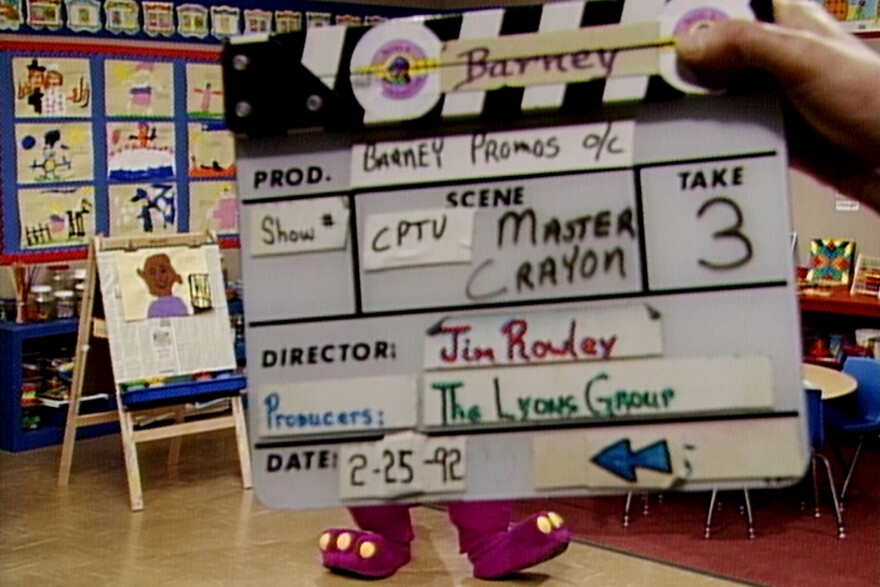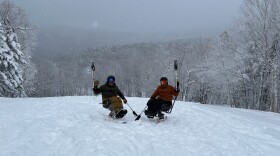Barney’s story starts in late 1987 in Allen, Texas. At the time, a former teacher named Sheryl Leach had a two-year old son, Patrick. She struggled to find videos that held his attention.
“I was a struggling mom at home with a very active two year old and I was stuck in traffic driving down north-central expressway,” Leach said in a local TV interview at the time. “And got the idea that if I could do a video series and put things into it that would hold the attention of a very young child, that it would be something that kids would love and parents would love, too.”
Other preschool-aged programs like “Sesame Street” and “Mister Rogers' Neighborhood” were still popular at that time, but both of those appealed to a wider age range. Sheryl wanted something just for toddlers.
When she couldn't find a program like that, she decided to make her own home video series with the help of her friend and fellow mom, Kathy Parker, and local video producer Dennis DeShazer.
Sheryl and her team got $1 million dollars from her father-in-law, Richard Leach, to make the home videos. He was an entrepreneur and publisher — and he also set up a video production company, the Lyons Group, to market the videos.
“In the beginning, in the first scripts, Barney was a teddy bear,” Leach said.
Technically, Barney went from a teddy bear, to a sea serpent named Cecilia, to Barney the dinosaur. Leach’s son, Patrick, had a role in that.
“The traveling dinosaur exhibit was touring Dallas and my little boy, Patrick, loved dinosaurs. So I teamed together with colleagues, Kathy Parker and Dennis de Shazer,” Leach said. “And I remember calling Kathy at the time and saying, how about a dinosaur instead of a teddy bear? And it was just a unanimous decision.”
“Barney and the Backyard Gang” didn’t originally air on TV. Instead, the videos were sold directly to the public.

Sheryl and her team targeted toy and gift stores. They recruited friends to spread the word, creating their own army of Barney Moms. They even partnered with the department store chain Neiman Marcus on a Barney product line.
The videos became pretty popular across Texas. But their success outside the state was still limited. Until a small twist of fate.
Barney’s Connecticut roots
Growing up, Leora Rifkin Edouard didn’t watch a lot of television. But on Super Bowl Sunday 1991, when she was just four years old, she asked her dad if they could go to their local video store in Prospect, Connecticut.
As Leora looked through the shelves, there was one video that caught her eye.
“I remember being like to the left of me,” Rifkin Edouard said. “Going to grab that video.”
The video was called “A Day At The Beach.” It had a red cover and smack dab in the center was a blueish-purple dinosaur wearing a little sailor’s hat and scarf standing on a boat full of kids.
When Leora and her dad got home, they popped in the video. Her dad went about his day. But Leora sat there, glued to the TV. And when it was done, she asked to watch it again.
“And in those days, you really had to help the child rewind the tape, so I had to keep going back in,” Rifkin said. “And then I decided, well, maybe it's worth my time to sit down and take a look at this.”
Leora’s dad, Larry Rifkin, did more than just look at what was on the screen. He looked at his daughter, Leora, who couldn’t turn away from it.
A big break on CPTV
Larry Rifkin wasn’t just any parent though. He happened to be in charge of programming for the state’s PBS station, CPTV, or as we call it today, Connecticut Public.
Now, Rifkin was not an expert on children’s television and CPTV was not a major player in public broadcasting, but PBS and the Corporation for Public Broadcasting had recently put out a call for more preschool programming.

And as a programmer, Rifkin understood how important it was to listen to your audience. Kids like Leora were Barney’s target audience.
“Up until that time, there was very little for a young child going down to age three, or four,” Rifkin said. “They like that slower pace, that linear storyline, they like a character with whom they can relate, who gives them unconditional appreciation for who they are and what they're feeling. And so Barney met a lot of things that we really didn't, as a system, offer yet.”
So Rifkin looked at the video’s back cover, found the name Sheryl Leach, and gave her a call.
“And lo and behold, I said to her, have you ever considered PBS? And she and her southern drawl said, ‘PBS? Tell me what that is,’” he said.
Sheryl Leach gave the OK. And so Rifkin pitched the show for national distribution.
The very next year, 1992, “Barney and the Backyard Gang” hit PBS as “Barney & Friends” and found its way into the homes of millions of kids.
“Barney was a one off,” Rifkin said. “As I say, Barney was a unicorn. He wasn't a dinosaur.”
Learn more
To hear more about the battle to keep “Barney & Friends” on the airwaves, tune in to Episode 1 “Toddler TV” and follow “Generation Barney” wherever you get your podcasts.
New episodes drop Tuesdays through December.








